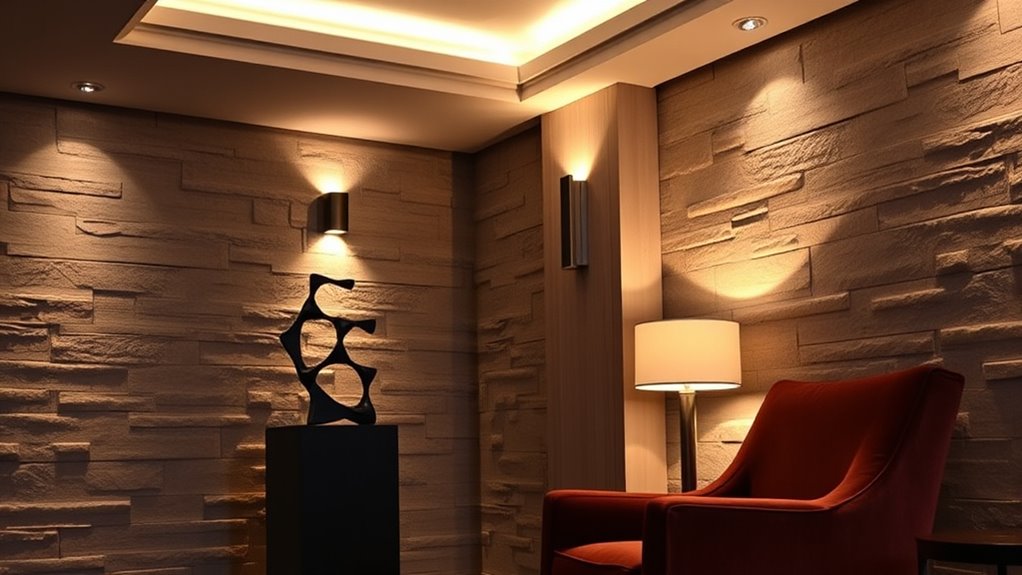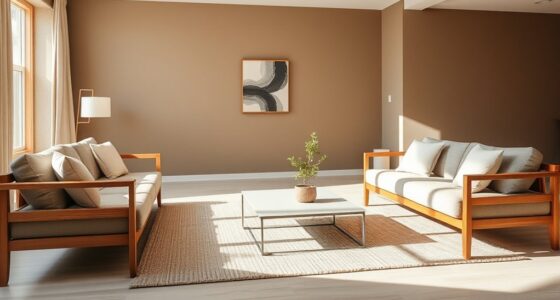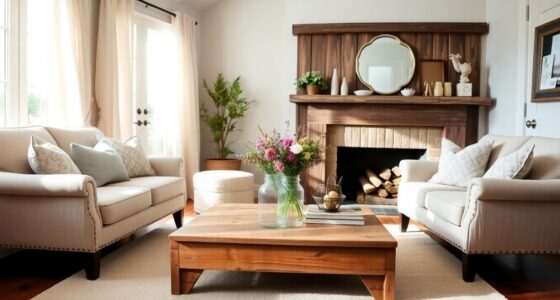A layered lighting scheme combines ambient, task, and accent lights to create a balanced, functional, and inviting space. By choosing fixtures that suit each layer—like ceiling lights for general illumination, focused task lights for work areas, and spotlights to highlight features—you enhance both mood and practicality. Adjusting color temperature and diffusion helps set the right atmosphere. To master this strategy and bring your space to life, explore more tips and techniques.
Key Takeaways
- Understand the principles of layering ambient, task, and accent lighting for balanced illumination.
- Choose fixtures that match your space’s aesthetic and serve specific lighting layers effectively.
- Use color temperature and diffusion techniques to create desired moods and prevent glare.
- Incorporate dynamic strategies like adjustable color temperatures and fixture placement for visual interest.
- Evaluate natural/light sources and select energy-efficient, dimmable fixtures for optimal functionality and ambiance.
Understanding the Fundamentals of Layered Lighting
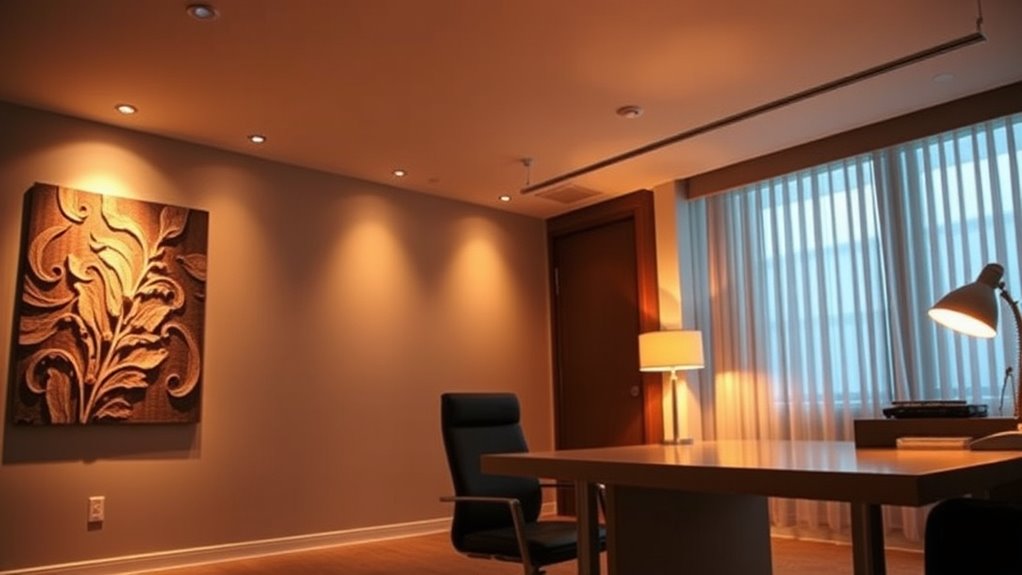
Layered lighting is essential for creating a balanced and functional space, but understanding its fundamentals helps you make smarter design choices. One key aspect is color temperature, which affects the mood and ambiance of your room. Warmer temperatures (around 2700K-3000K) create cozy, inviting environments, while cooler temps (4000K-5000K) promote alertness and focus. Light diffusion also plays a crucial role; it softens harsh shadows and spreads light evenly, enhancing comfort and visual appeal. Choosing fixtures with appropriate diffusion helps prevent glare and creates a more natural, seamless progression between different lighting layers. Additionally, incorporating self watering plant pots can bring a touch of greenery that enhances the layered lighting effect by adding natural textures and visual interest. By understanding how color temperature and light diffusion work together, you can craft a layered lighting scheme that’s both functional and aesthetically pleasing.
Balancing Ambient, Task, and Accent Lighting
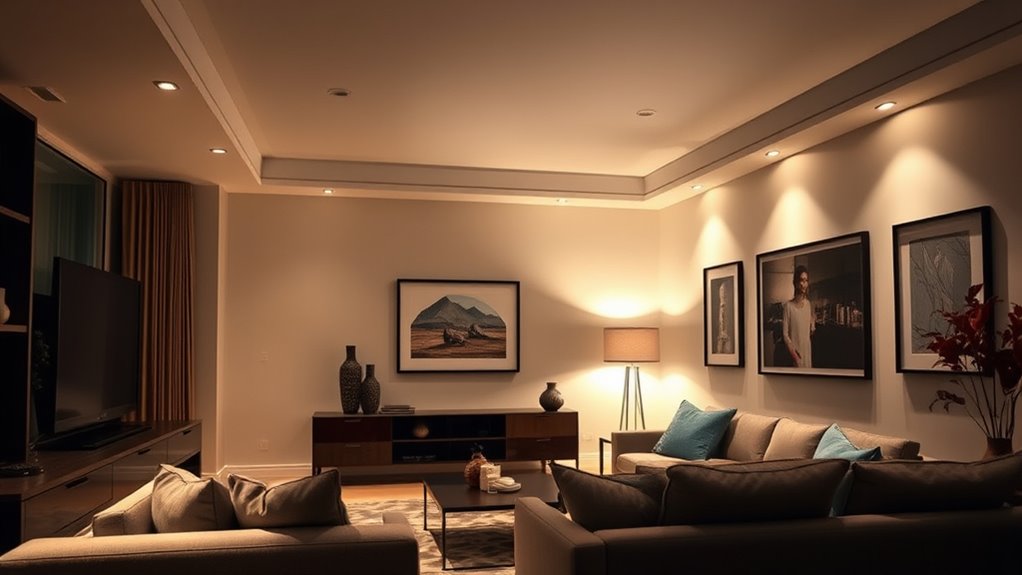
Achieving a well-balanced lighting scheme involves carefully coordinating ambient, task, and accent lighting to suit your space’s needs. To do this effectively, consider color temperature: warmer tones create cozy atmospheres, while cooler tones promote alertness. Use lighting controls to adjust brightness and switch layers seamlessly, ensuring each layer complements the others. Incorporating active listening techniques within your lighting design can enhance the overall ambiance and functionality of your space.
Choosing the Right Fixtures for Every Layer

How do you select the right fixtures to effectively illuminate each layer? Start by considering fixture styles that match your space’s aesthetic—sleek modern, vintage, or industrial. For ambient lighting, opt for ceiling-mounted fixtures or recessed lights with soft glow bulb types like warm LEDs. Task lighting requires focused fixtures such as pendants or under-cabinet lights, with bright, crisp bulbs for clarity. Accent lighting benefits from adjustable spotlights or wall sconces that highlight artwork or architectural features. Keep these tips in mind:
- Choose fixture styles that blend seamlessly with your decor
- Select bulb types that deliver the right brightness and color temperature
- Use adjustable fixtures for flexibility and precise control
- When selecting fixtures, consider the lighting layer they will serve to ensure balanced illumination across your space
This approach assures each layer is functional and visually appealing.
Creative Strategies for Dynamic Lighting Design
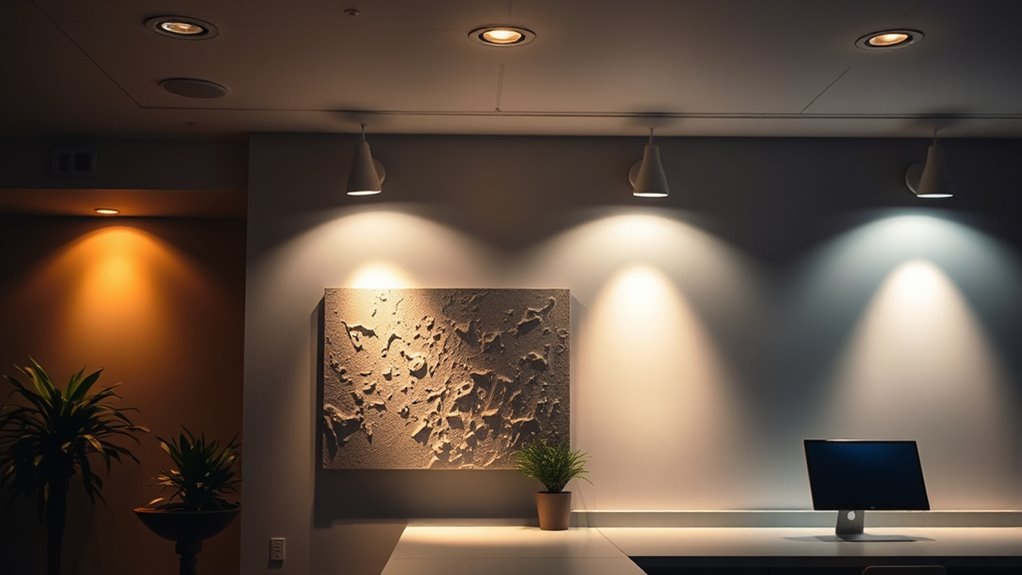
Integrating creative strategies into your lighting design transforms functional layers into a dynamic visual experience. To achieve this, think about adjusting color temperature to evoke mood or highlight specific areas. Warmer tones create intimacy, while cooler tones add energy. Fixture placement is equally important; position lights to emphasize architectural features or create focal points. Experiment with layering different light sources to add depth and interest. Use varied fixture heights and angles to break uniformity and guide the eye through the space. Incorporate accent and task lighting creatively, blending them seamlessly. Here’s a quick look at some strategies:
| Strategy | Description |
|---|---|
| Color temperature | Varies warmth to influence mood |
| Fixture placement | Position to highlight or conceal architectural details |
| Layering lights | Combine ambient, task, and accent for depth |
| Angled lighting | Create visual interest and focus |
| Mood control | Use dimming and color for dynamic ambiance |
Adding layered lighting techniques can significantly enhance the overall ambiance and visual interest of your space.
Practical Tips for Implementing Layered Lighting in Your Space
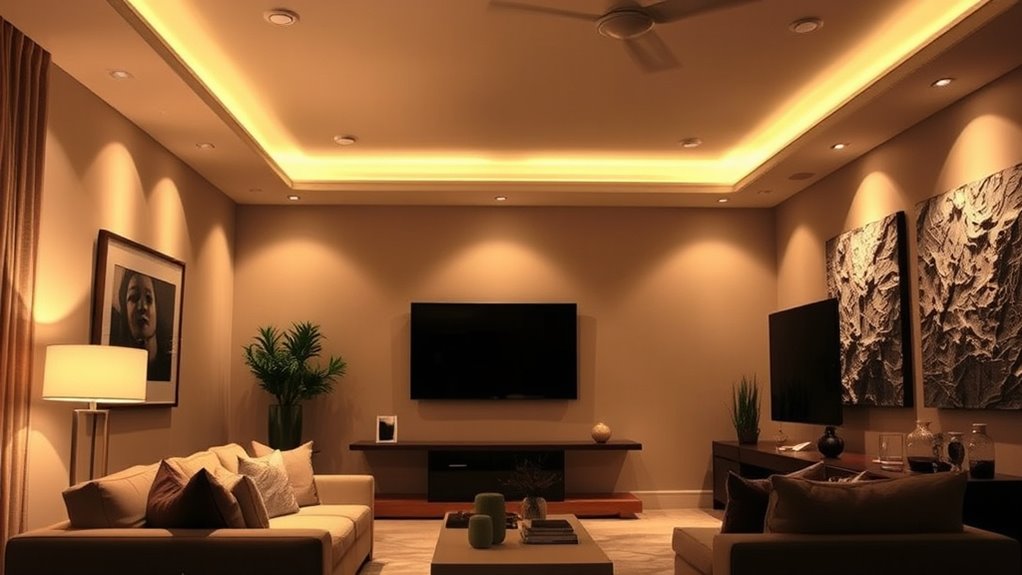
To effectively implement layered lighting in your space, start by evaluating the room’s natural and existing light sources. This helps you determine where to add layers for balance and functionality. When choosing fixtures, consider color temperature to set the right mood—warm light creates comfort, while cooler tones boost focus. Prioritize energy efficiency by selecting LED bulbs and dimmable options to reduce electricity use and extend bulb life. Understanding the importance of professional guidance can ensure your lighting design aligns with the space’s purpose and enhances its ambiance.
Frequently Asked Questions
How Does Layered Lighting Influence Mood and Ambiance?
Layered lighting considerably influences mood and ambiance by combining different fixture placements and adjusting color temperature to suit your space. Warm tones create cozy, inviting atmospheres, while cooler temperatures energize a room. By strategically placing fixtures at various levels, you highlight focal points and add depth, making your space feel dynamic and comfortable. You control the mood effortlessly, tailoring lighting layers to match your desired ambiance.
What Are Common Mistakes to Avoid in Layered Lighting Design?
Imagine your space as a symphony, where poor bulb selection or fixture placement creates discord. You should avoid over-illuminating or under-illuminating areas, which can flatten the ambiance. Focus on balanced lighting layers, choosing bulbs that complement each other, and place fixtures thoughtfully to highlight key features. Neglecting these details risks a chaotic or dull environment, undermining the mood you want to craft with your layered lighting design.
How Can Smart Lighting Technology Enhance Layered Lighting Schemes?
Smart lighting technology can greatly enhance your layered lighting schemes by offering smart controls and automation features. With these tools, you can easily adjust brightness, color, and timing to suit different moods and activities. Automation allows your lights to respond automatically to your schedule or natural light levels, creating a seamless, personalized ambiance. This integration ensures your lighting setup is both flexible and energy-efficient, elevating your space effortlessly.
What Are Eco-Friendly Options for Layered Lighting Fixtures?
You can choose eco-friendly options for layered lighting by selecting fixtures made from sustainable materials like bamboo, recycled metal, or glass. Opt for energy-efficient fixtures such as LED bulbs, which reduce energy consumption and last longer. Incorporating dimmable switches also helps you control brightness, saving even more energy. These choices promote sustainability while providing versatile lighting layers that enhance your space’s ambiance and functionality.
How Do I Adapt Layered Lighting for Small Versus Large Spaces?
When adapting layered lighting for small or large spaces, focus on space planning and fixture selection. In small areas, choose compact fixtures and avoid clutter, using fewer layers to prevent overwhelming the space. For large rooms, incorporate multiple lighting layers like ambient, task, and accent lighting, selecting fixtures that distribute light evenly. Adjust the intensity and placement based on the room’s size to create a balanced, functional environment.
Conclusion
By mastering the magic of layered lighting, you’ll create enchanting, cozy, and functional spaces. Embrace the artistry of ambient, task, and accent lighting to craft dynamic, delightful designs. With thoughtful fixtures and clever concepts, you’ll transform your space into a stunning sanctuary. Remember, the key is knowing your layers, playing with precision, and pushing your creative boundaries. Light up your life with confidence, and let your luminous legacy truly shine.
